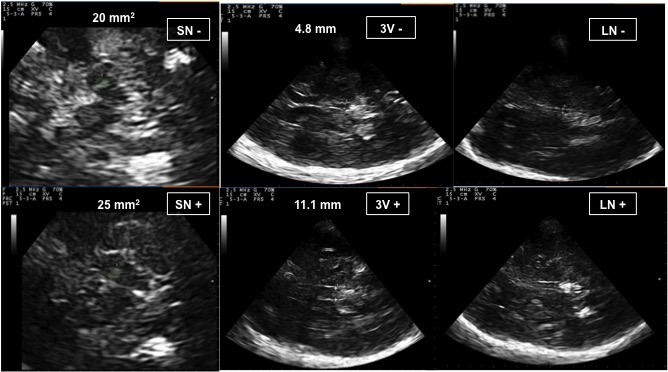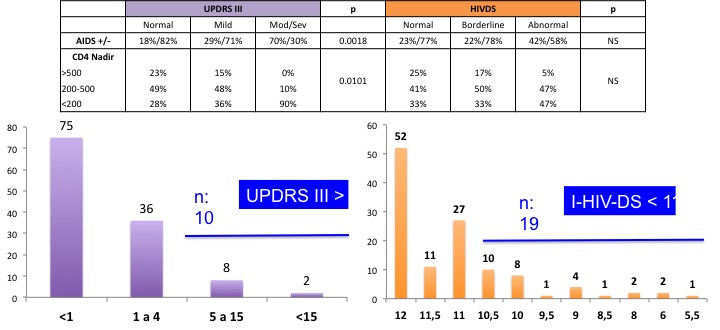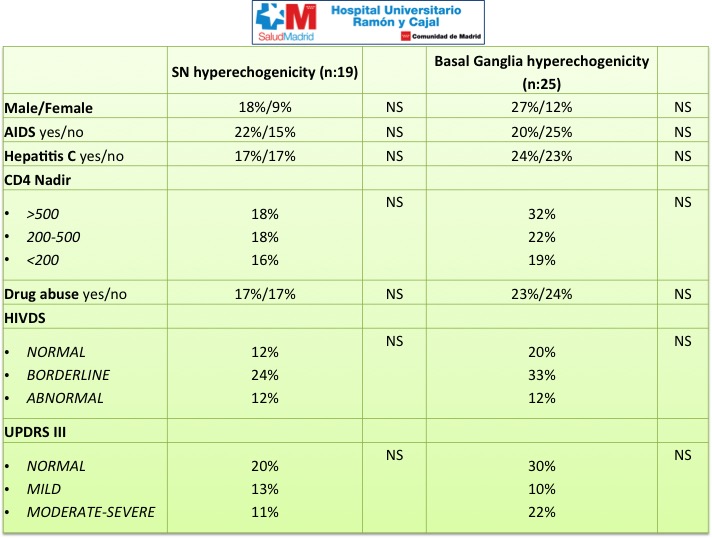Category: Neuroimaging (Non-PD)
Objective: To study whether transcranial sonography of brain parenchyma shows features with a potential association with clinical and neurological variables in human immunodeficiency virus (HIV) infection.
Background: HIV infection associates an increased frequency of neurological symptoms due to the infection itself and immunosuppression. Transcranial sonography (TCS) depicts abnormalities in substantia nigra (SN), third ventricle (3V) and basal ganglia (BG), useful for parkinson’s disease diagnosis. A former study found an association among SN hyperechogenicity and motor performance in 40 HIV patients.
Method: Transversal study of consecutive outpatient HIV subjects with neurological (UPDRSIII and International HIV dementia scale) and TCS assessment, with a sample of 132 historic control subjects for comparison of ultrasound variables (Figure1).
Results: 123 subjects (80% male, 43±13 years old, 15±12 years of HIV infection, 32% with CD4 nadir < 200, 25% fulfilling AIDS criteria, 26% HCV co-infection) were included in a 6-days period. Seven had history of neurological complications (3 stroke, 2 HIV encephalitis, 2 toxoplasmosis, 1 multifocal progressive leukoencephalopathy, 1 varicella-zoster encephalitis). Nineteen subjects scored <11 in I-HIV-DS and 10 (4%) over 5 in UPDRSIII: the later was associated with AIDS diagnosis and lowest CD4 nadir (Figure2). Among 115 (93%) with sufficient transtemporal bone window, 19 had SN hyperechogenicity (17% vs. 11% controls, NS), seven 3V enlargement (6% vs. 5%, NS) and 31 BG hyperechogenicity (30% vs. 9%, p:0.00043), without association with any infectious or neurological clinical variable (Figure 3). MRI was available in 4 cases with BG hyperechogenicity and was abnormal in all them.
Conclusion: SN hyperechogenicity was not more frequent in HIV+ than in control subjects, unlike previous evidence suggested. Conversely, an increased prevalence of BG hyperechogenicities of unknown significance, previously not described, was found.
References: Berg D, Godau J, Walter U. Transcranial sonography in movement disorders. Lancet Neurol. 2008;7(11):1044-1055. doi:10.1016/S1474-4422(08)70239-4. Behnke S, Berg D, Naumann M, Becker G. Differentiation of Parkinson’s disease and atypical parkinsonian syndromes by transcranial ultrasound. J Neurol Neurosurg Psychiatry. 2005;76(3):423-425. Berardelli A, Wenning GK, Antonini A, et al. EFNS/MDS-ES/ENS [corrected] recommendations for the diagnosis of Parkinson’s disease. Eur J Neurol. 2013;20(1):16-34. doi:10.1111/ene.12022. Mark Obermann M. Ku¨per O. Kastrup O. Yaldizli S. Esser, J. Thiermann E. Koutsilieri G. Arendt H.-C. Diener M. Maschke for the German Competence Network HIV/AIDS. Substantia nigra hyperechogenicity and CSF dopamine depletion in HIV. J Neurol (2009) 256:948–953
To cite this abstract in AMA style:
A. Alonso-Canovas, J. Martinez Poles, M.J Pérez Elías, J.L Casado Osorio, A.M Moreno Zamora, C. Quereda Rodríguez-Navarro, E. Navas Elorza, F. Dronda Núñez, M.J Vivancos Gallego, S. Moreno Guillen, J. Masjuan, J.C Martinez Castrillo, I. Corral. Transcranial sonography in HIV infection: Does it reflect infectious and neurological symptoms? [abstract]. Mov Disord. 2020; 35 (suppl 1). https://www.mdsabstracts.org/abstract/transcranial-sonography-in-hiv-infection-does-it-reflect-infectious-and-neurological-symptoms/. Accessed January 6, 2026.« Back to MDS Virtual Congress 2020
MDS Abstracts - https://www.mdsabstracts.org/abstract/transcranial-sonography-in-hiv-infection-does-it-reflect-infectious-and-neurological-symptoms/



